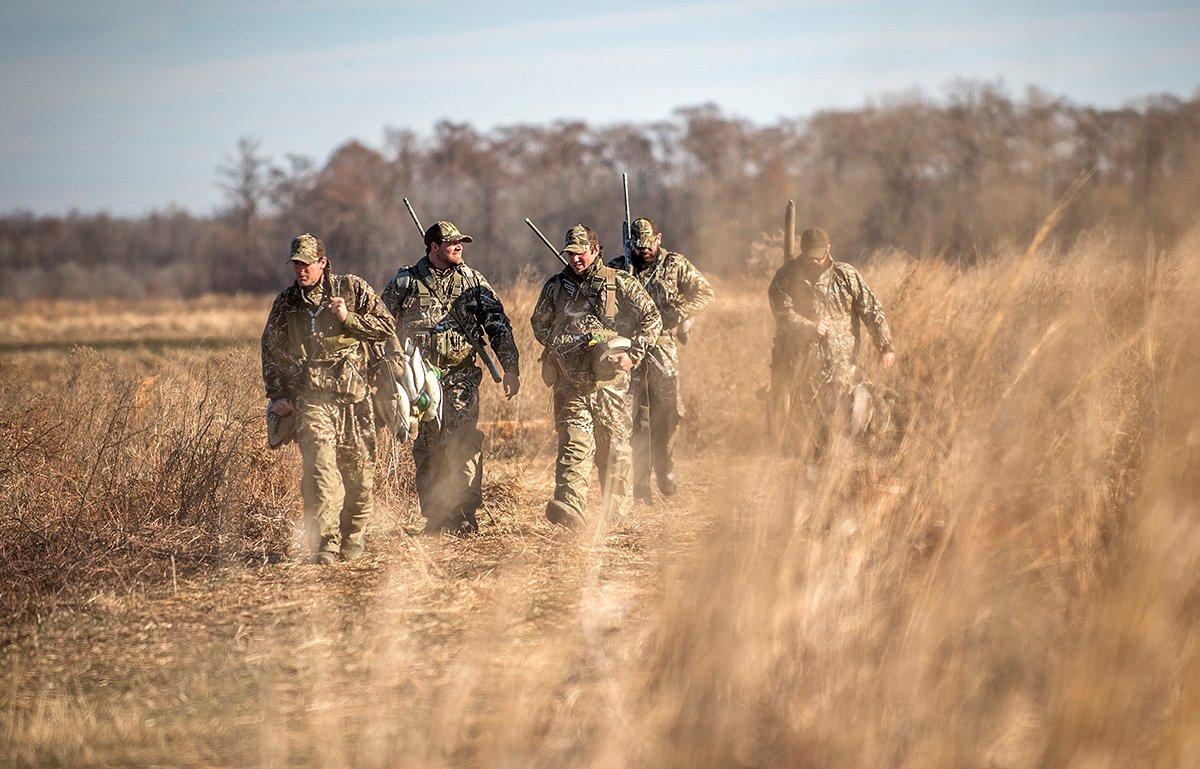It can be tough for even a couple of hunters to stay concealed from ducks and geese, but a crowd can seem impossible

But when you add several other hunters to the equation — perhaps folks who can't sit still or want to stare at passing birds — the concealment equation becomes tricky. That's why many guides use elaborate blinds or deep pits that prevent clients from spooking ducks and geese.
Of course, most folks don't have pits or permanent blinds, so concealing multiple hunters — say four or more — can be tough. Great camo patterns help. Also, modern resources and old-fashioned woodcraft provide further solutions for covering a crowd.
Using Natural Cover
Making maximum use of natural cover is the easiest way to conceal a group. That's fairly intuitive in some situations, such as flooded timber, where folks can fan out and select prime trees by which to hide. When hunting dry fields or big water, however, your choices might be limited.
Bottom line: Use any available cover to your advantage. In fields, set up in grassy ditches, by rock piles or fence lines, or in small patches of standing crops, even if those spots are a bit off the X. Likewise, along shorelines of sloughs, lakes or rivers, take advantage of any backdrop that obscures your silhouette and vegetation in which you can sit or crouch.
Always strive to keep the sun at your back, and don't be stubborn about keeping everyone together if some hunters might be exposed. Before the shooting starts, view your setup from a distance to see how well the group is hidden. One hunter might be more visible than others, and you'll want to correct that.
Try Frame-Style Blinds
Frame blinds have become more popular in recent years, for good reason. They're easy to set up, and they hide several hunters. And although they require some work and assembly, they're especially good options for hunters who can't or don't want to use layout blinds or sit uncomfortably in cover.
During a September 2020 hunt with MaXXed Out Guides in Minnesota, friends from ALPS Outdoorz and I used the company's new Alpha A-Frame Blind to hunt the open shoreline of a small prairie slough. In the dark, we positioned two of the blinds side by side, and then several hunters slid inside and hunkered down. The birds that graced our spread that day had no clue we were there.
Go With a Classic
Layout blinds have long been favorites of hunters in cover-challenged situations, such as harvested fields or river sandbars. But large groups of blinds can create several suspicious-looking blobs instead of one, giving ducks and geese more opportunity to spot danger.
Solution: Instead of spreading blinds out, place them side by side, almost touching. Then, use natural materials — cornstalks or other stubble, for example — to fill in the gaps, fronts and backs of the blinds, essentially creating one large hide. This requires substantial labor, and quarters can be cramped. But it's far more effective than keeping blinds separate.
During the second day of the ALPS hunt in Minnesota, we set 10 of the company's Zero Gravity and Legend layouts in a tight row, and then covered the group in cornstalks and other vegetation. The result? A full limit of big honkers — most of which landed or hovered feet-down above the decoys — in about 20 minutes.
Certainly, those Minnesota hunts involved extra planning and effort. But the success we experienced with hiding a group made it more than worthwhile.
Click here for more Realtree waterfowl hunting content. And check us out on Facebook.






